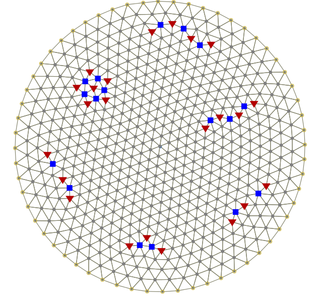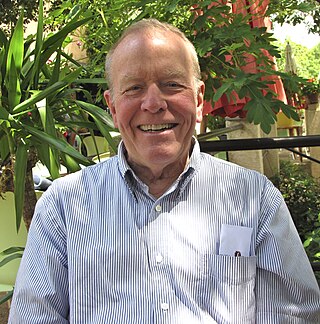Related Research Articles

Monte Carlo methods, or Monte Carlo experiments, are a broad class of computational algorithms that rely on repeated random sampling to obtain numerical results. The underlying concept is to use randomness to solve problems that might be deterministic in principle. The name comes from the Monte Carlo Casino in Monaco, where the primary developer of the method, physicist Stanislaw Ulam, was inspired by his uncle's gambling habits.

Fermi liquid theory is a theoretical model of interacting fermions that describes the normal state of the conduction electrons in most metals at sufficiently low temperatures. The theory describes the behavior of many-body systems of particles in which the interactions between particles may be strong. The phenomenological theory of Fermi liquids was introduced by the Soviet physicist Lev Davidovich Landau in 1956, and later developed by Alexei Abrikosov and Isaak Khalatnikov using diagrammatic perturbation theory. The theory explains why some of the properties of an interacting fermion system are very similar to those of the ideal Fermi gas, and why other properties differ.

Lattice QCD is a well-established non-perturbative approach to solving the quantum chromodynamics (QCD) theory of quarks and gluons. It is a lattice gauge theory formulated on a grid or lattice of points in space and time. When the size of the lattice is taken infinitely large and its sites infinitesimally close to each other, the continuum QCD is recovered.
Jellium, also known as the uniform electron gas (UEG) or homogeneous electron gas (HEG), is a quantum mechanical model of interacting electrons in a solid where the positive charges are assumed to be uniformly distributed in space; the electron density is a uniform quantity as well in space. This model allows one to focus on the effects in solids that occur due to the quantum nature of electrons and their mutual repulsive interactions without explicit introduction of the atomic lattice and structure making up a real material. Jellium is often used in solid-state physics as a simple model of delocalized electrons in a metal, where it can qualitatively reproduce features of real metals such as screening, plasmons, Wigner crystallization and Friedel oscillations.
Quantum Monte Carlo encompasses a large family of computational methods whose common aim is the study of complex quantum systems. One of the major goals of these approaches is to provide a reliable solution of the quantum many-body problem. The diverse flavors of quantum Monte Carlo approaches all share the common use of the Monte Carlo method to handle the multi-dimensional integrals that arise in the different formulations of the many-body problem.

A Wigner crystal is the solid (crystalline) phase of electrons first predicted by Eugene Wigner in 1934. A gas of electrons moving in a uniform, inert, neutralizing background will crystallize and form a lattice if the electron density is less than a critical value. This is because the potential energy dominates the kinetic energy at low densities, so the detailed spatial arrangement of the electrons becomes important. To minimize the potential energy, the electrons form a bcc lattice in 3D, a triangular lattice in 2D and an evenly spaced lattice in 1D. Most experimentally observed Wigner clusters exist due to the presence of the external confinement, i.e. external potential trap. As a consequence, deviations from the b.c.c or triangular lattice are observed. A crystalline state of the 2D electron gas can also be realized by applying a sufficiently strong magnetic field. However, it is still not clear whether it is the Wigner crystallization that has led to observation of insulating behaviour in magnetotransport measurements on 2D electron systems, since other candidates are present, such as Anderson localization.
Auxiliary-field Monte Carlo is a method that allows the calculation, by use of Monte Carlo techniques, of averages of operators in many-body quantum mechanical or classical problems.
In computational physics, variational Monte Carlo (VMC) is a quantum Monte Carlo method that applies the variational method to approximate the ground state of a quantum system.
Gaussian Quantum Monte Carlo is a quantum Monte Carlo method that shows a potential solution to the fermion sign problem without the deficiencies of alternative approaches. Instead of the Hilbert space, this method works in the space of density matrices that can be spanned by an over-complete basis of gaussian operators using only positive coefficients. Containing only quadratic forms of the fermionic operators, no anti-commuting variables occur and any quantum state can be expressed as a real probability distribution.
Path integral Monte Carlo (PIMC) is a quantum Monte Carlo method used to solve quantum statistical mechanics problems numerically within the path integral formulation. The application of Monte Carlo methods to path integral simulations of condensed matter systems was first pursued in a key paper by John A. Barker.

Positron annihilation spectroscopy (PAS) or sometimes specifically referred to as positron annihilation lifetime spectroscopy (PALS) is a non-destructive spectroscopy technique to study voids and defects in solids.
In applied mathematics, the numerical sign problem is the problem of numerically evaluating the integral of a highly oscillatory function of a large number of variables. Numerical methods fail because of the near-cancellation of the positive and negative contributions to the integral. Each has to be integrated to very high precision in order for their difference to be obtained with useful accuracy.
Solid hydrogen is the solid state of the element hydrogen, achieved by decreasing the temperature below hydrogen's melting point of 14.01 K. It was collected for the first time by James Dewar in 1899 and published with the title "Sur la solidification de l'hydrogène" in the Annales de Chimie et de Physique, 7th series, vol. 18, Oct. 1899. Solid hydrogen has a density of 0.086 g/cm3 making it one of the lowest-density solids.
In condensed matter physics, biexcitons are created from two free excitons.
Stopping and Range of Ions in Matter (SRIM) is a group of computer programs which calculate interactions between ions and matter; the core of SRIM is a program called Transport of Ions in Matter (TRIM). SRIM is popular in the ion implantation research and technology community, and also used widely in other branches of radiation material science.
Michael D. Towler is a theoretical physicist associated with the Cavendish Laboratory of the University of Cambridge and formerly research associate at University College, London and College Lecturer at Emmanuel College, Cambridge. He created and owns the Towler Institute in Vallico di Sotto in Tuscany, Italy.

Quantum ESPRESSO is a suite for first-principles electronic-structure calculations and materials modeling, distributed for free and as free software under the GNU General Public License. It is based on density-functional theory, plane wave basis sets, and pseudopotentials. ESPRESSO is an acronym for opEn-Source Package for Research in Electronic Structure, Simulation, and Optimization.

James Bernhard Anderson was an American chemist and physicist. From 1995 to 2014 he was Evan Pugh Professor of Chemistry and Physics at the Pennsylvania State University. He specialized in Quantum Chemistry by Monte Carlo methods, molecular dynamics of reactive collisions, kinetics and mechanisms of gas phase reactions, and rare-event theory.
In many-body physics, the problem of analytic continuation is that of numerically extracting the spectral density of a Green function given its values on the imaginary axis. It is a necessary post-processing step for calculating dynamical properties of physical systems from Quantum Monte Carlo simulations, which often compute Green function values only at imaginary times or Matsubara frequencies.
References
- ↑ R. J. Needs, M. D. Towler, N. D. Drummond and P. Lopez Rios, J. Phys.: Condens. Matter 22, 023201 (2010).
- ↑ R. J. Needs, M. D. Towler, N. D. Drummond, P. Lopez Rios and J. R. Trail, J. Chem. Phys. 152, 154106 (2020).